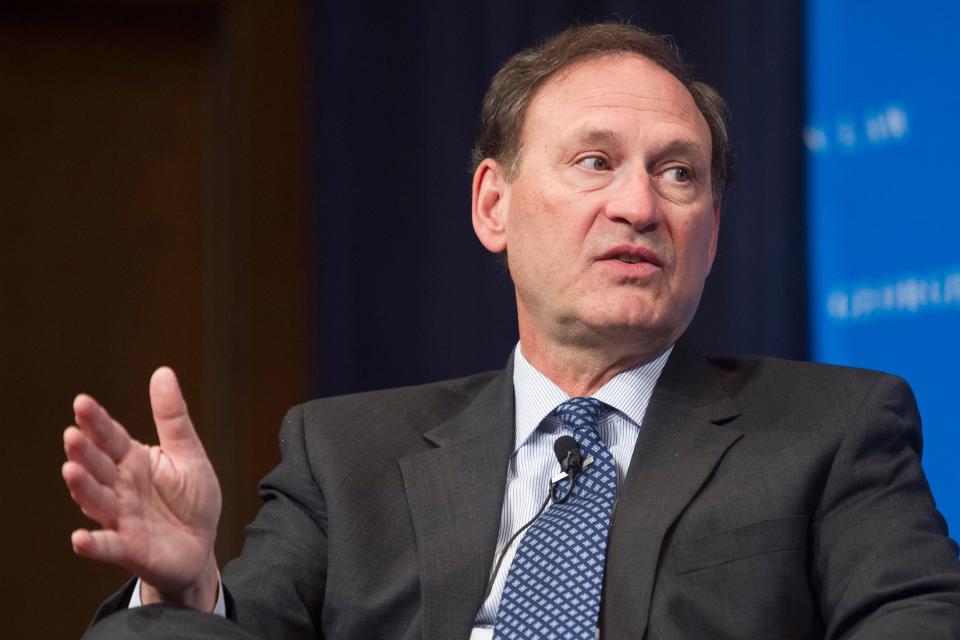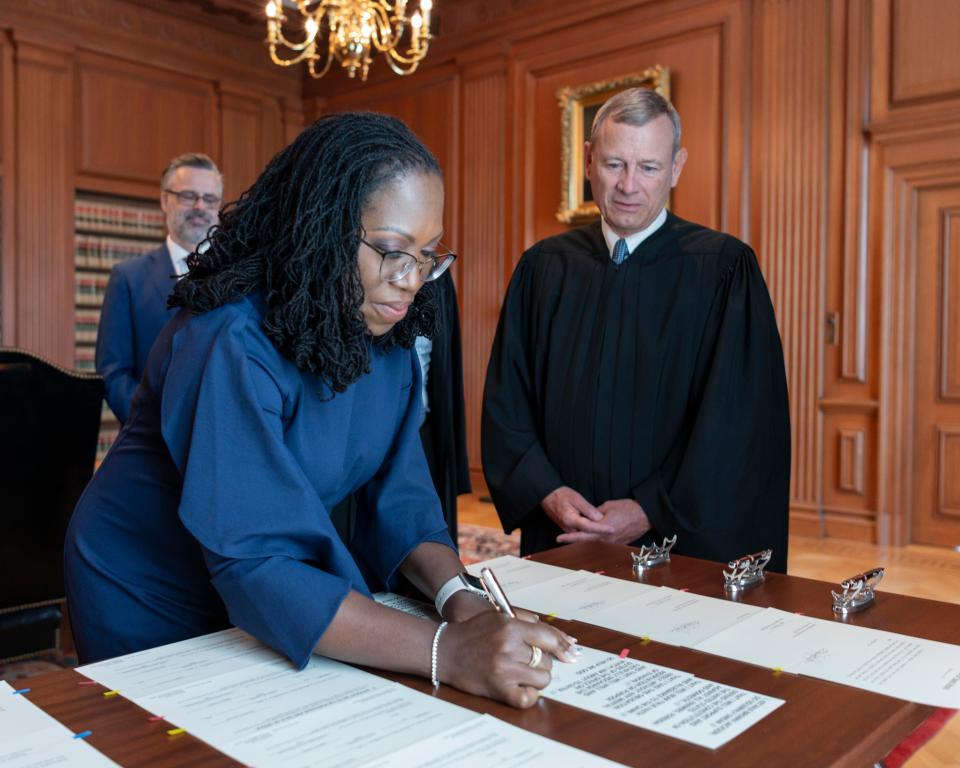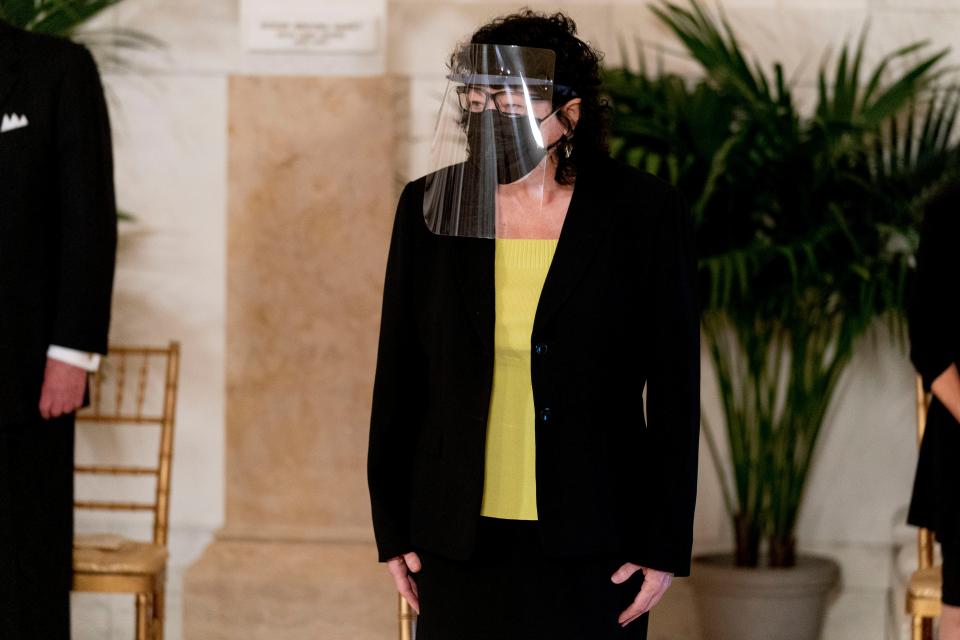'New territory': Supreme Court ends historic term with big shift to the right on abortion, guns
WASHINGTON – Back when the Supreme Court justices took their seats last fall for the first time since the COVID-19 pandemic shuttered their majestic courtroom, the hot controversy was whether too many cases were being decided without oral argument.
Nine months later, after a bombshell term that brought about the overturning of Roe v. Wade, the striking down of at least one and potentially many other gun laws and a rethinking of the separation between church and state, the court has thrust itself into America's culture wars in a way experts say the nation has not witnessed in decades.
With a 6-3 advantage bolstered by President Donald Trump's three nominees, the high court's conservatives aligned in decision after decision – often reaching beyond a narrow outcome to set new standards that could affect the law for years, or even decades, to come.
Confidence: Ruling overturning Roe sparks debate about Supreme Court's legitimacy
Graphic: What does overturning Roe mean? A breakdown of the abortion ruling
Roberts: Chief justice wanted to go slow curbing Roe. His colleagues were in a hurry.
The latest example landed Thursday, on the final day of the court's 2021-2022 term, when a 6-3 majority not only ruled the Environmental Protection Agency lacks authority to regulate power plant emissions, but also appeared to significantly limit the ability of other federal agencies to craft regulations absent clear guidance from Congress.
"This is a court that has turned sharply to the right," said David Cole, national legal director at the American Civil Liberties Union. "The court abandoned consensus, abandoned moderation, abandoned restraint in favor of the exercise of raw power."
For conservatives, the court's latest rulings were the culmination of a generation-long push not only to seat more right-leaning justices, but also to promote originalism, or the idea of interpreting the words of the Constitution as the framers would have understood them. Though the 1973 decision in Roe establishing the constitutional right to abortion wasn't the genesis of that philosophy, it did help fuel its success.
"This is a resounding win for the rule of law," Carrie Severino, president of the conservative Judicial Crisis Network said. "This whole term has been an illustration of the incredible success of having a majority of justices on the Supreme Court who are really committed to originalism, to interpreting the Constitution as it's written."
All sides seemed to agree the term was as chaotic as it was historic, with an unprecedented leak in May of a draft opinion in the abortion case, protests that forced police to erect a massive fence around the court, and a debate about whether the justices were injecting themselves into the kind of partisan fray that has divided the nation or whether they were simply pulling themselves out of those quandaries, handing the difficult decisions on guns and abortion off to Congress and the states.
"If you just look at the cases one by one, there was no one decision that really surprised me," said Richard Fallon, a professor at Harvard Law School. "But then if you step back and look at the effect cumulatively, it is clear that we have a very, very, very conservative court that ... seldom exhibited restraint in not going as far as one would have expected."

Precarious precedents
It was the top headline from the term: a five-justice majority overturned Roe v. Wade that five decades earlier established a constitutional right to abortion. Associate Justice Samuel Alito, a conservative who wrote for the court's majority, spent 37 pages – nearly half of the opinion – explaining why the court was justified in taking the unusual step of wiping out one of its best-known, if perhaps most controversial, precedents.
The Supreme Court rarely overturns its decisions. The principle of stare decisis – the adherence to prior rulings – gives stability to the law. But "rarely" doesn't mean "never." Alito was eager to point out, in a footnote in the abortion decision that ran for two pages, all of the prior cases the court had overturned, from segregation to bans on sodomy.
Honoring precedent, Alito wrote, is "the norm" but not "an inexorable command."
But Roe and the court's subsequent abortion decision in 1992, Planned Parenthood v. Casey, weren't the only precedents to come under attack this term, only the most notable. The conservative majority on its own also curbed at least two others.
Precedent: The court has overruled itself plenty. Roe was the latest causality.
In a major ruling in favor of a public high school coach who lost his job for praying on the 50-yard line after games, the court abandoned a test from 1971 used to determine when governments crossed a line when it comes to religion. The test prohibited government from favoring or inhibiting religion or excessively entangling church and state. It was also, Associate Justice Neil Gorsuch wrote, completely unworkable.

"This court long ago abandoned Lemon," Gorsuch wrote in ruling in favor of Joseph Kennedy, the praying coach.
While it didn't overturn another precedent from 1971, it severely limited it. Ruling against the owner of an inn on the Canadian border who sued U.S. Customs and Border Protection for excessive force after an altercation, the court ruled there are almost no circumstances in which people may sue federal police for civil rights violations.
Ascendant conservatives
In the rare instances when they do speak publicly, the justices of the Supreme Court like to stress the idea that their work isn't political, that conservative and liberal partisan ideologies have nothing to do with interpreting the law. But the argument has come under fire on the left after a series of major decisions have mostly landed to the right.
This term, the progressive position won in only a few major cases. Back in January, the court refused to block the House committee investigating the Jan. 6 Capitol attack from getting Trump administration documents. And on Thursday, the court ruled 5-4 the Biden administration could end a Trump-era policy requiring migrants to wait in Mexico while their asylum requests are processed.
![Former Bremerton High School assistant football coach Joe Kennedy was in the national spotlight over his refusal to stop praying at the 50-yard line following games. Kennedy said his fight with the school district. [Via MerlinFTP Drop]](https://s.yimg.com/ny/api/res/1.2/O2krqYOzWNhscO3WIVv2fQ--/YXBwaWQ9aGlnaGxhbmRlcjt3PTk2MA--/https://media.zenfs.com/en/usa_today_news_641/c2e63303449c88f91279f91cfb8b2689)
It shot down the Biden administration's mandate that large employers set up COVID-19 vaccine or testing requirements, its effort to impose climate regulations on power plants, and its support of New York's gun regulations. The court allowed a Texas ban on most abortions after six weeks, upheld Mississippi's abortion ban at 15 weeks, and sided with Texas Sen. Ted Cruz in his challenge to campaign finance regulations.
In each of those cases, justices nominated by Republican presidents lined up in the majority, and the justices nominated by Democratic presidents dissented. Occasionally, Chief Justice John Roberts would join the liberal bloc or write on his own.
Fallon stressed that observers of the court don't see it as partisan in the traditional sense of that word, the idea that the justices are trying to help one political party or another win elections. But the court's 6-3 split between conservative and liberal judicial philosophies has changed the dynamic in ways that became more clear this term.
"In terms of the numbers, we are, insofar as the modern era is concerned, in new territory," Fallon said. "And yes, I think those new numbers have produced a remarkable number of cases in which the conservatives won, often by 6 to 3."
A first: Ketanji Brown Jackson makes history as Supreme Court's first Black woman justice
That may explain why trust in the Supreme Court is slipping on the left. Several polls in the days since the Mississippi abortion case was decided have shown that a majority of Americans disapprove of the court, though the declines appear to be driven mainly by Democratic voters. An NPR/PBS NewsHour/Marist poll this week found most people, by a 57%-to-36% margin, feel the abortion decision was mostly based on politics.

Chaos at the court
Supreme Court justices like to describe their workplace as one of collegiality, where everyone disagrees on legal matters but are nevertheless great friends. But the nine-month term that ended Thursday exposed rifts at the court that made it seem much closer to how Justice Oliver Wendell Holmes described it: nine scorpions in a bottle.
The term started with an open debate over the court's emergency docket, where cases are decided on an expedited basis without oral argument. After a series of high-profile matters were decided on that docket, including a case involving Texas' ban on most abortions after six weeks of pregnancy, the court came under intense scrutiny. Alito called the criticism "rank nonsense," but concerns over the court's procedures wound their way into a number of opinions, including from Alito's fellow conservatives.

In the end, the court moved several emergency appeals to its regular docket, including the Texas abortion case, a challenge to Biden's vaccine mandate and an appeal from a death row inmate who wanted to have physical contact with his pastor at the time of his execution.
A few months later, NPR reported tensions between Associate Justices Sonia Sotomayor and Gorsuch over the court's COVID-19 protocols. Gorsuch, at one point, was the only member of the court who declined to wear a mask. Sotomayor, who sits next to Gorsuch, is diabetic and always wore a mask at arguments. In a joint statement, the two pushed back on suggestions of animosity between them.
Grip: Chief Justice Roberts facing test of leadership amid tense time at Supreme Court
Leak: A clerk? A justice? Answers scarce on who leaked draft Supreme Court opinion
And then came the leak in May of Alito's draft opinion in the Mississippi abortion case, an unprecedented breach of protocol that suggested everything was not well behind the curtain at the court. The disclosure of the draft prompted protests across the country, including at the justices' homes, but also hinted at a more fundamental breakdown.

"When you lose that trust, especially in the institution that I'm in, it changes the institution fundamentally. You begin to look over your shoulder," Associate Justice Clarence Thomas said at an event in Dallas in May. "It's like kind of an infidelity – that you can explain it but you can't undo it."
History and tradition
One of the more subtle – but important – shifts that took place in the Supreme Court's major decisions this term was a greater emphasis on the history and tradition of how the law was applied at the the Constitution was drafted. In his 63-page majority opinion striking down New York's gun laws, Thomas said that in order to pass constitutional muster, a gun regulation must be "consistent with this nation's historical tradition of firearm regulation."
In his opinion overturning Roe v. Wade, Alito focused heavily on the history of abortion laws in the states when the Fourteenth Amendment was adopted in 1868. At that time, Alito wrote, three-quarters of states had made abortion a crime at any stage.
Historical analysis has long been a part of the abortion and guns debates, and it was a major component of the majority opinion in Roe. But the focus has become more pronounced as the conservative legal movement has stressed originalism.

"What's changed? Well, the court is much more originalist than it used to be," Fallon said. "And so if you're an originalist, then history is a reference point."
But history is debatable, experts note. Critics of Alito's argument point out that women didn't have much of a political voice to raise in dissent on abortion back in 1868, for instance. The 19th Amendment giving women the vote wasn't ratified until 1920 – more than five decades later. Did the laws then truly reflect the nation's viewpoint as a whole?
"'People' did not ratify the Fourteenth Amendment. Men did," the court's three liberals wrote in their dissent in the abortion case. "So it is perhaps not so surprising that the ratifiers were not perfectly attuned to the importance of reproductive rights for women’s liberty, or for their capacity to participate as equal members of our nation."
This article originally appeared on USA TODAY: Abortion, guns: Supreme Court ends historic term with hard right turn

